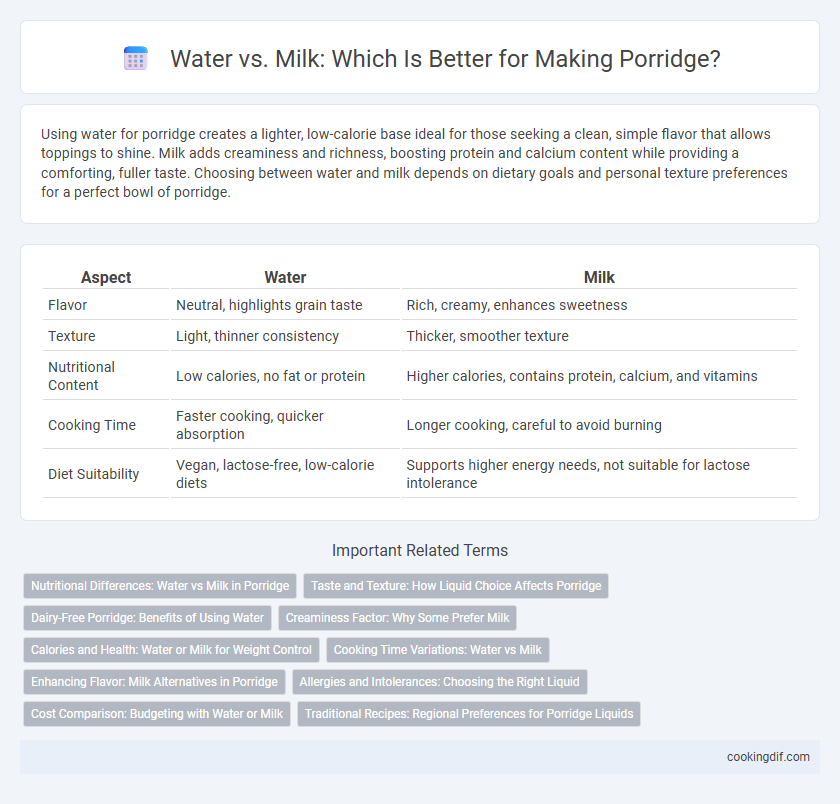Using water for porridge creates a lighter, low-calorie base ideal for those seeking a clean, simple flavor that allows toppings to shine. Milk adds creaminess and richness, boosting protein and calcium content while providing a comforting, fuller taste. Choosing between water and milk depends on dietary goals and personal texture preferences for a perfect bowl of porridge.
Table of Comparison
| Aspect | Water | Milk |
|---|---|---|
| Flavor | Neutral, highlights grain taste | Rich, creamy, enhances sweetness |
| Texture | Light, thinner consistency | Thicker, smoother texture |
| Nutritional Content | Low calories, no fat or protein | Higher calories, contains protein, calcium, and vitamins |
| Cooking Time | Faster cooking, quicker absorption | Longer cooking, careful to avoid burning |
| Diet Suitability | Vegan, lactose-free, low-calorie diets | Supports higher energy needs, not suitable for lactose intolerance |
Nutritional Differences: Water vs Milk in Porridge
Using milk instead of water to cook porridge significantly enhances its nutritional profile by increasing protein, calcium, and vitamin D content, essential for bone health and muscle function. Water-based porridge provides fewer calories and lacks these micronutrients but offers a low-fat, hydrating alternative suitable for calorie-conscious diets. Choosing milk contributes to creamier texture and higher energy density, making it beneficial for individuals seeking nutrient-dense meals.
Taste and Texture: How Liquid Choice Affects Porridge
Choosing milk for porridge enriches its taste with a creamy, slightly sweet flavor and creates a smoother, thicker texture. Using water results in a lighter, more neutral taste that allows toppings and spices to stand out while producing a looser, more porridge-like consistency. The liquid choice significantly influences the porridge's mouthfeel and flavor profile, making milk ideal for indulgent recipes and water best for lighter, more refreshing bowls.
Dairy-Free Porridge: Benefits of Using Water
Using water instead of milk for porridge creates a dairy-free option suitable for lactose-intolerant individuals and those following vegan diets. Water-based porridge has fewer calories and less fat, making it a lighter, more easily digestible breakfast choice. This method maintains the porridge's nutritional benefits while accommodating dietary restrictions and promoting hydration.
Creaminess Factor: Why Some Prefer Milk
Milk enhances porridge's creaminess by adding natural fats and proteins that water lacks, resulting in a richer texture and smoother consistency. The lactose in milk contributes slight sweetness, elevating the flavor profile without needing extra sugar. This creamy quality makes milk a preferred choice for those seeking a comforting and indulgent breakfast experience.
Calories and Health: Water or Milk for Weight Control
Using water to cook porridge significantly reduces calorie content, making it a preferred choice for weight control as water contains zero calories. Milk adds creaminess and essential nutrients like calcium and protein but increases the calorie count, which may impact weight management. Choosing water supports lower calorie intake, while milk provides additional nutritional benefits that can aid in satiety and muscle maintenance.
Cooking Time Variations: Water vs Milk
Cooking porridge with water typically results in a faster cooking time, often taking around 5 to 10 minutes due to the lower density and boiling point compared to milk. Milk-based porridge requires a longer simmer, usually 10 to 15 minutes, as milk's proteins and fats thicken slowly and promote a creamier texture. The choice between water and milk directly influences the porridge's cooking duration and final consistency, impacting both texture and nutrient retention.
Enhancing Flavor: Milk Alternatives in Porridge
Milk alternatives such as almond, oat, and coconut milk enhance porridge flavor by adding natural sweetness and creaminess, creating a richer texture compared to water. These plant-based milks also introduce subtle nutty or fruity notes, complementing the oats without overpowering their natural taste. Using milk alternatives increases the nutritional profile of porridge by adding vitamins, minerals, and healthy fats that water alone cannot provide.
Allergies and Intolerances: Choosing the Right Liquid
Water offers a hypoallergenic option for porridge, eliminating risk for those with dairy allergies or lactose intolerance, while milk provides additional nutrients like calcium and protein. Plant-based milk alternatives such as almond, soy, or oat milk suit individuals with dairy sensitivities and contribute varying flavors and nutritional profiles. Selecting the right liquid depends on dietary restrictions, allergy considerations, and desired nutritional content for optimal porridge consumption.
Cost Comparison: Budgeting with Water or Milk
Using water for porridge significantly reduces costs compared to milk, making it a budget-friendly option for daily meals. Milk enhances flavor and nutritional value, but its higher price impacts overall food expenses, especially for larger quantities. Budget-conscious individuals often opt for water, balancing affordability with basic porridge preparation.
Traditional Recipes: Regional Preferences for Porridge Liquids
Traditional porridge recipes vary significantly in their choice of liquid, with water commonly used in Northern European countries for a lighter texture and lower calorie content. In contrast, milk is preferred in many Mediterranean and Eastern European regions to create a creamier consistency and richer flavor profile. The choice between water and milk in porridge preparation reflects cultural tastes and nutritional preferences unique to each region.
Water vs Milk for porridge Infographic

 cookingdif.com
cookingdif.com